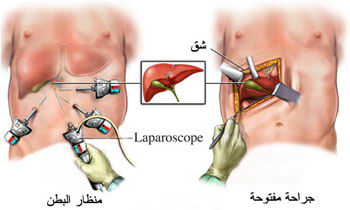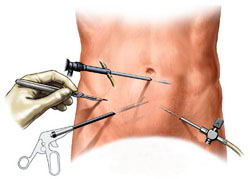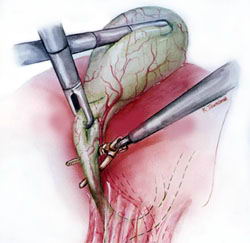Gallstone
In medicine, gallstones (choleliths) are crystalline bodies formed within the body by accretion or concretion of normal or abnormal bile components.
Cholesterol stones are usually green, but are sometimes white or yellow in color and account for about 80 percent of gallstones. They are made primarily of cholesterol.
Pigment stones are small, dark stones made of bilirubin and calcium salts that are found in bile. They account for the other 20 percent of gallstones. Risk factors for pigment stones include cirrhosis, biliary tract infections, and hereditary blood cell disorders, such as sickle cell anemia. Stones of mixed origin also occur.
Gallstones can occur anywhere within the biliary tree, including the gallbladder and the common bile duct. Obstruction of the common bile duct is choledocholithiasis; obstruction of the biliary tree can cause jaundice; obstruction of the outlet of the pancreatic exocrine system can cause pancreatitis. Cholelithiasis is the presence of stones in the gallbladder - chole- means "gall bladder", lithia meaning "stone", and -sis means "process".
Gallstones vary in size and may be as small as a grain of sand or as large as a golf ball. The gallbladder may develop a single, often large, stone or many smaller ones, even several thousand.
Gallstones are, oddly, a valuable by-product of meat processing, fetching
up to $900 US an ounce in their use as a purported aphrodisiac in the
herbal medicine of some cultures. The finest gallstones tend to be sourced
from old dairy cows. Much as in the manner of diamond mines, slaughterhouses
carefully scrutinise offal department workers for gallstone theft.
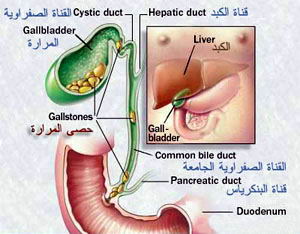
Causes :
Progress has been made in understanding the process of gallstone formation. Researchers believe that gallstones may be caused by a combination of factors, including inherited body chemistry, body weight, gallbladder motility (movement), and perhaps diet.
Cholesterol gallstones develop when bile contains too much cholesterol and not enough bile salts. Besides a high concentration of cholesterol, two other factors seem to be important in causing gallstones. The first is how often and how well the gallbladder contracts; incomplete and infrequent emptying of the gallbladder may cause the bile to become overconcentrated and contribute to gallstone formation. The second factor is the presence of proteins in the liver and bile that either promote or inhibit cholesterol crystallization into gallstones.
In addition, increased levels of the hormone estrogen as a result of pregnancy, hormone therapy, or the use of birth control pills, may increase cholesterol levels in bile and also decrease gallbladder movement, resulting in gallstone formation.
No clear relationship has been proven between diet and gallstone formation. However, low-fiber, high-cholesterol diets, and diets high in starchy foods have been suggested as contributing to gallstone formation.
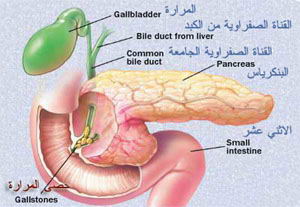
Symptoms :
A main symptom of gallstones is commonly referred to as a gallstone "attack", in which a person will experience intense pain in the upper abdominal region that steadily increases for approximately thirty minutes to several hours. A victim may also encounter pain in the back, ordinarily between the shoulder blades, or pain under the right shoulder. Sometimes, vomiting or nausea occurs. In some cases, the pain actually develops in the lower region of the stomach, nearer to the pelvis, but this is less common.
These attacks are intensely painful, similar to that of a kidneystone attack. It is believed by some that gallstone attacks are as painful as or even surpass the intense pain of childbirth. One way to alleviate this feeling is to drink a full glass of water at the start of an attack to regulate the bile in the gallbladder, but this does not work in all cases.
Often, these attacks occur after a particularly fatty meal and almost always happen at night. Other symptoms include abdominal bloating, intolerance of fatty foods, belching, gas, and indigestion. If the above symptoms coincide with chills, lowgrade fever, yellowing of the skin or eyes, and/or clay-colored stool, a doctor should be consulted immediately.
Some people who have gallstones are asymptomatic and do not feel any pain or discomfort. These gallstones are called "silent stones" and do not affect the gallbladder or other internal organs. They do not need treatment.
Medical options :
Cholesterol gallstones can sometimes be dissolved by oral ursodeoxycholic acid. This drug is very expensive, however, and the gallstones may recur once the drug is stopped. Obstruction of the common bile duct with gallstones can sometimes be relieved by endoscopic retrograde sphinceterotomy (ERS) following endoscopic retrograde cholangiopancreatography (ERCP).
Surgical options :
Cholecystectomy (gallbladder removal) has a 99% chance of eliminating the recurrence of cholelithiasis. Only symptomatic patients must be indicated to surgery. The lack of a gall bladder does not seem to have any negative consequences in many people. However, there is a significant proportion of the population, between 5-40%, who develop a condition called postcholecystectomy syndrome. Symptoms include gastrointestinal distress and persistent pain in the upper right abdomen.
There are two surgery options: open procedure and laparoscopic: see the cholecystectomy article for more details.
- Open procedure: This involves a large incision into the abdomen (laparotomy) below the right lower ribs. A week of hospitalization, normal diet a week after release and normal activity a month after release.
- Laparoscopic:
3-4 small puncture holes for camera and instruments (available since
the 1980s). Typically same-day release or one night hospital stay, followed
by a week of home rest and pain medication. Can resume normal diet and
light activity a week after release. (Decreased energy level and minor
residual pain for a month or two.) Studies have shown that this procedure
is as effective as the more invasive open cholecystectomy, provided
the stones are accurately located by cholangiogram prior to the procedure
so that they can all be removed.
